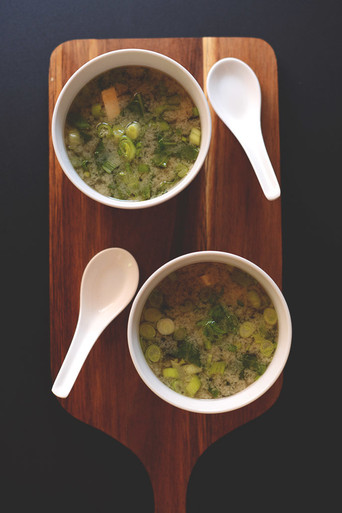Miso Soup: It Does a Gut Good
Posted by Zebra Organics on 2022 Apr 12th
Although some people are only now becoming aware of fermented foods and the many health benefits they offer, humans have been consuming them for thousands of years. Initially used as a preservation method, today, we also know that fermented foods can help reduce the risk of cardiovascular disease, high blood pressure, diabetes, obesity and inflammation, and more. Additionally, fermented foods are good for the gut. They increase the gut's beneficial bacteria. A healthy gut contributes to and supports mental health, cognitive function, and immune health.
Fermented foods have one thing in common – all are made with microorganisms. However, not all foods that are made through fermentation contain live microorganisms by they end up on your plate. For example, heat from baking or cooking can destroy microorganisms. Though rendered less beneficial, fermented foods even when cooked or baked, can add variety, texture and great taste to one's diet. There are thousands of fermented foods consumed by people around the world. Some of the most commonly found are yogurt, sauerkraut, tofu, tempeh, kimchi, apple cider vinegar, kefir, kombucha, pickles, sourdough bread and miso.
Miso can be used to enhance salad dressings, marinades, dipping sauces and more. One of our favorites ways to incorporate miso into the diet is miso soup. Miso has long been considered a food that promotes good health and a long, happy life. Its origins can be traced to China as far back as the 4th century BC. It later made its way to Japan. Many readers are likely accustomed to eating miso soup at a Japanese restaurant and might not realize it is actually easy to make at home.
Photo credit: Minimalist Baker
So what is miso? Miso is a protein-rich paste traditionally made by fermenting soybeans with salt, koji (the fungus Aspergillus oryzae) and grain for the fungus to grow on. It is commonly made with barley or rice, but rye or buckwheat are also used. The fermentation period can last from just a few weeks and up to three years. Generally, the longer miso ferments, the darker and stronger-tasting it becomes. It varies in color (red, yellow, brown or white) and flavor depending on the ingredients. Miso is often described as having a salty and savory (umami) taste.
Miso offers a variety of health benefits. It is high in essential amino acids and antioxidants, rich in minerals like zinc, copper, and manganese, and is a good source of Vitamin K and various B vitamins. Miso is also loaded with beneficial bacteria and living enzymes that aid digestion and assimilation. Some studies suggest miso might also boost the immune system and help ward off infections. For most people, miso is a good addition to one's eating routine. However for those on low-salt diets or blood thinners, limiting one's intake of miso might be in order. And with such a high percentage of the soybeans grown today being GMO, it is best, if possible, to use organic miso.
Speaking of soybeans, tofu is an excellent ingredient to add to miso soup. Be sure to use silken (organic) tofu, not firm or extra-firm, and cut it into small cubes. With its softer, more delicate consistency, silken tofu perfectly completes any cup or bowl of miso soup. When making miso soup, never add the miso to boiling water or broth. The intense heat will destroy the beneficial microbes. Instead, remove the soup from the heat, allow it to cool down some, and then stir or whisk in the miso paste. The liquid will still be warm enough to melt the miso. A little miso goes a long way. We point this out because when using miso for soup or in other recipes, you will have leftover paste. Unopened miso paste can be kept at room temperature for long periods of time. Once opened however, miso should be stored in a closed container and refrigerated. If properly refrigerated, miso can last up to a year but the flavor might diminish.
The Minimalist Baker has a wonderful recipe for a super-simple, plant-based miso soup that uses just six ingredients. From start to finish, it takes only 15-minutes to make. We particularly like this recipe. It's rich in miso flavor and it's more hearty than might be expected because it's loaded with greens. It's not the classic recipe for miso soup but it's easy, tastes great and still provides excellent nutrition. We recommend using a high-quality, organic brand of miso to further maximize the health benefits.
Feature Photo by Ryutaro Uozumi on Unsplash.
{{widget type="Magento\CatalogWidget\Block\Product\ProductsList" title="Barley Miso, Organic, Yamaki 2 year aged, 16 oz - Ohsawa" show_pager="0" products_count="1" template="Magento_CatalogWidget::product/widget/content/grid.phtml" conditions_encoded="^[`1`:^[`type`:`Magento||CatalogWidget||Model||Rule||Condition||Combine`,`aggregator`:`all`,`value`:`1`,`new_child`:``^],`1--1`:^[`type`:`Magento||CatalogWidget||Model||Rule||Condition||Product`,`attribute`:`sku`,`operator`:`==`,`value`:`441`^]^]"}}


